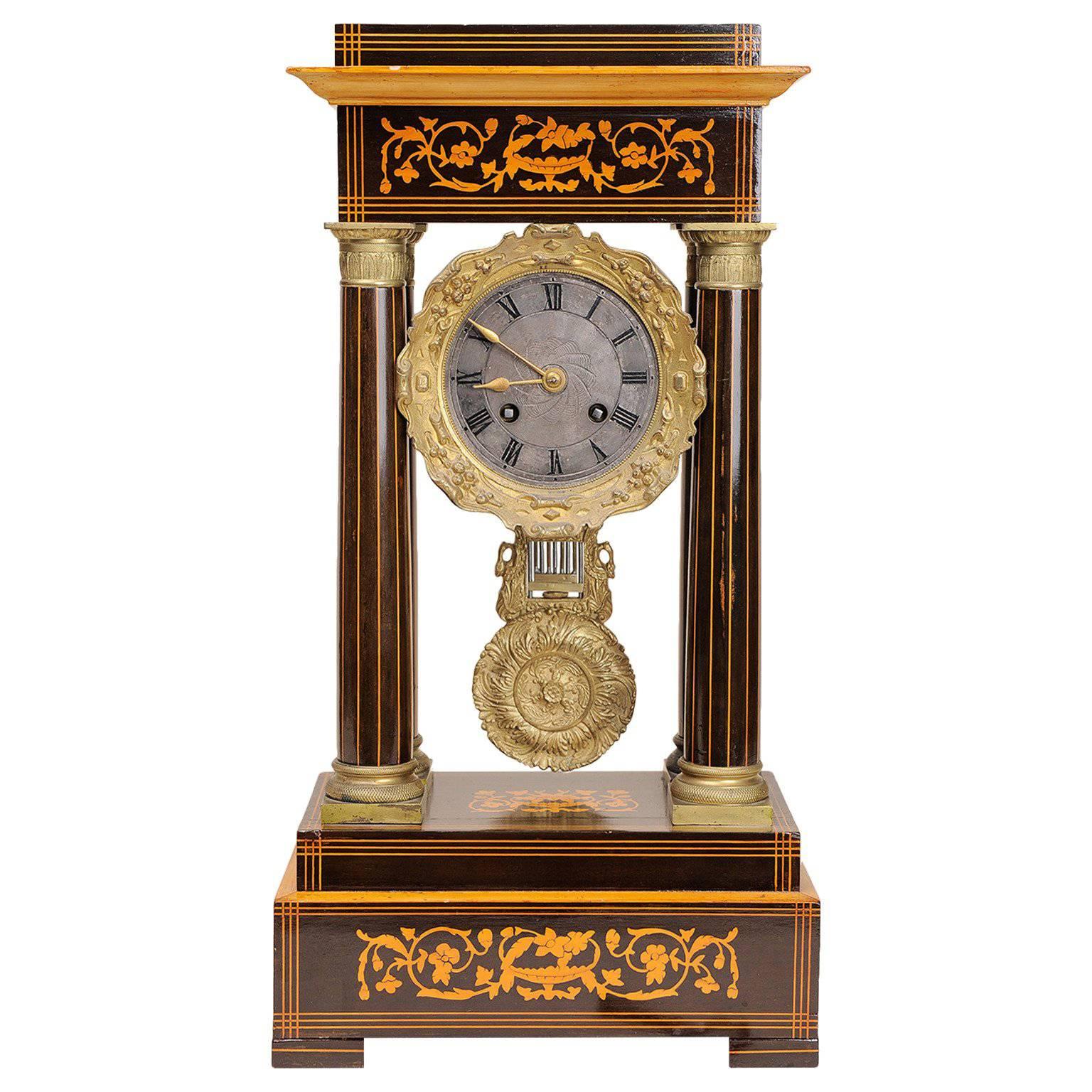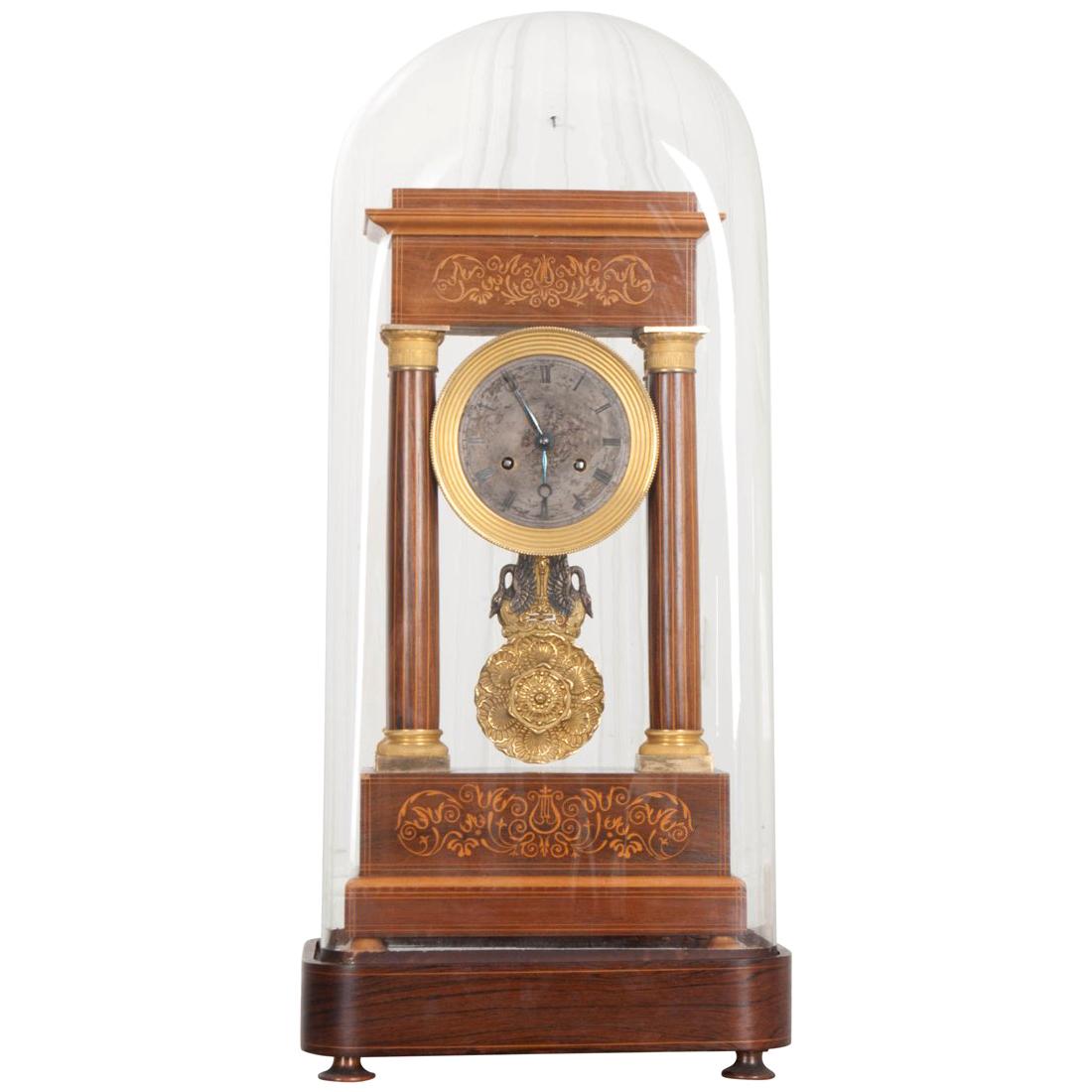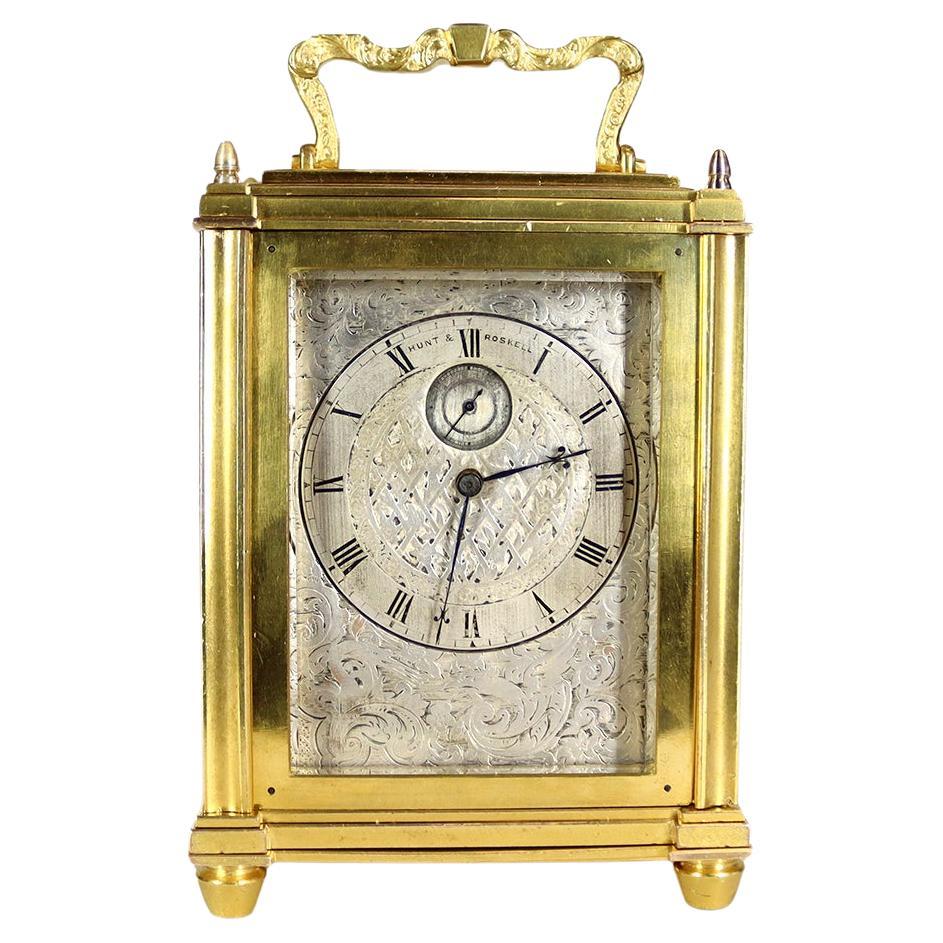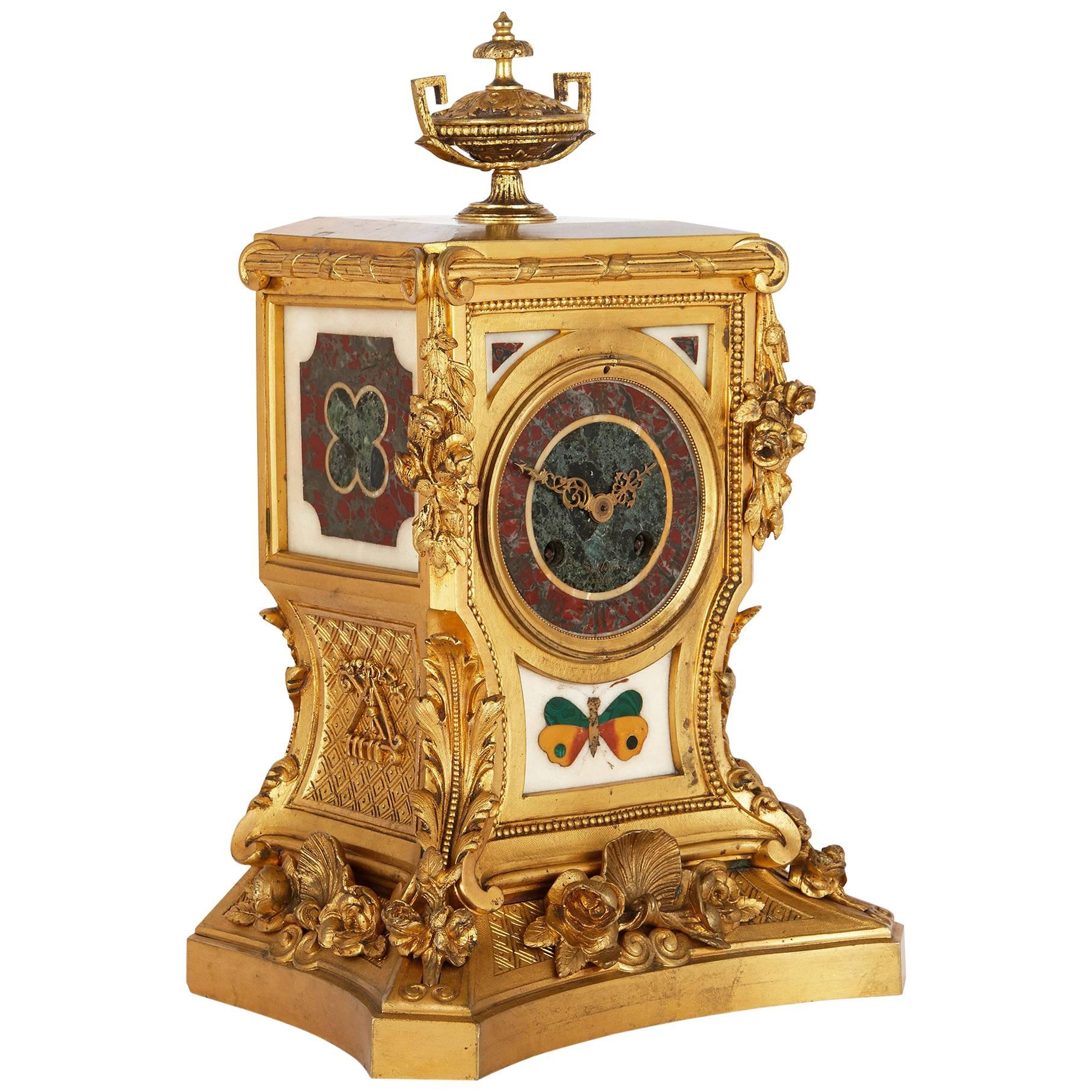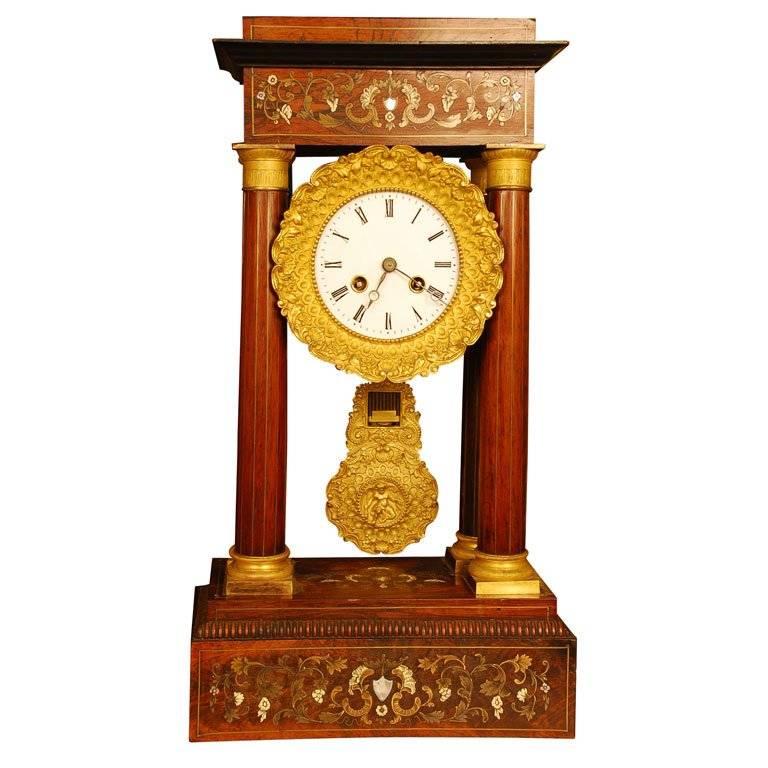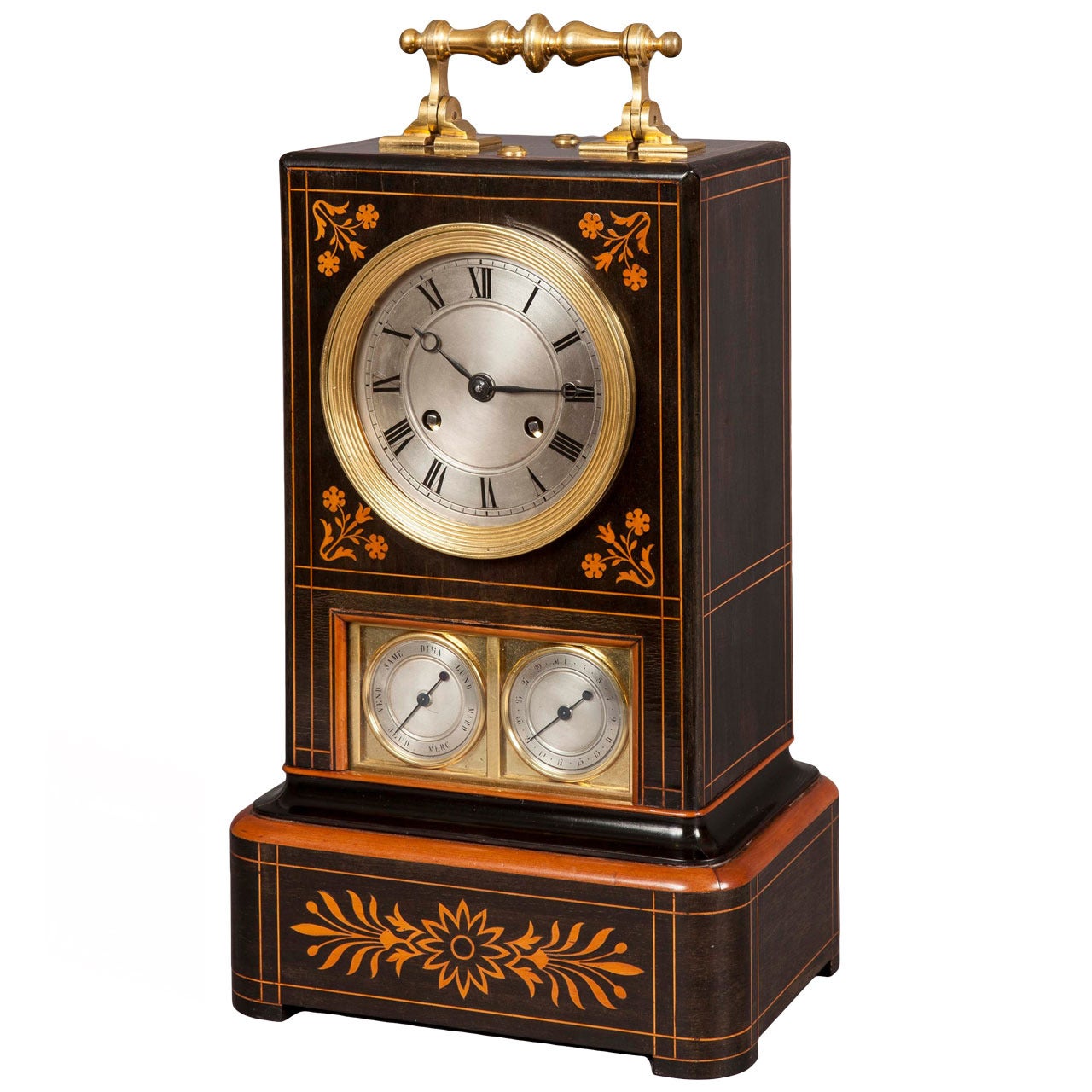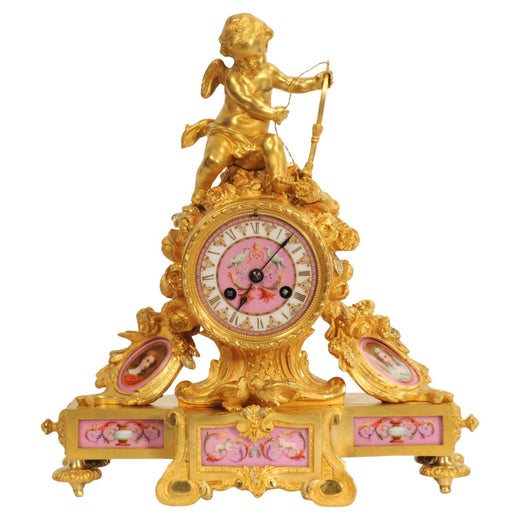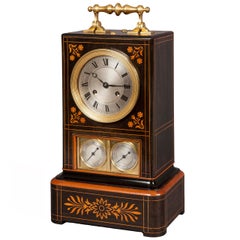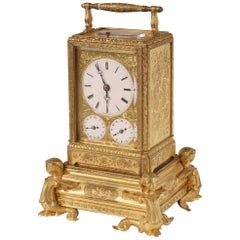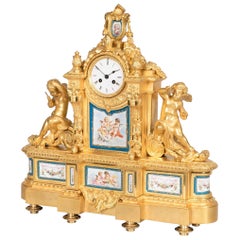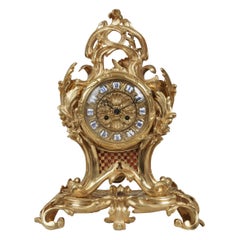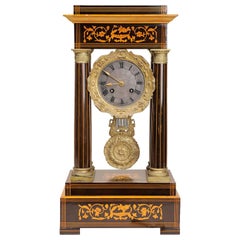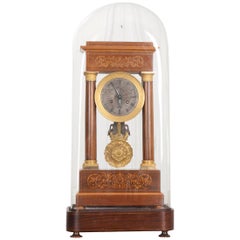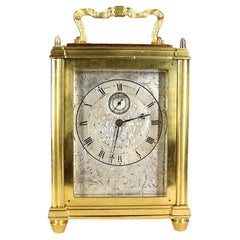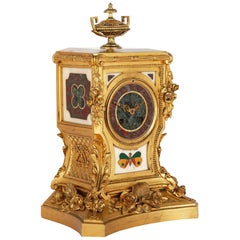Items Similar to Very Rare 19th Century Coromandel Veneered Year-Running Clock by Thomas Cole
Want more images or videos?
Request additional images or videos from the seller
1 of 13
Very Rare 19th Century Coromandel Veneered Year-Running Clock by Thomas Cole
$113,588.42
£85,000
€98,592.03
CA$160,105.72
A$175,827.16
CHF 91,820.23
MX$2,098,570.11
NOK 1,163,274.39
SEK 1,084,217.53
DKK 736,354
About the Item
A Superb Coromandel-Veneered Mantle Clock
The case constructed of very well-figured Coromandel giving the maximum amount of decorative effect, with gilt bronze accents; the plinth base of rectangular form, with everted stepped corners, and precisely chased gilt bronze figures, two representing Mercury-the god of travel and merchants with his winged helmet and coin purse in hand; the others representing Fortuna-the goddess of luck; the sides glazed, with mooresque arcaded pierced mounts enclosing a vase, in gilt bronze with overlapping palm trees above: the top of domed form with an octagonal platform, surmounted by an architectural dome, its engraved detail and structure reminiscent of Byzantine prototypes. The silvered chapter ring with Roman numerals for the hours, and within an arabesque dial divided into quadrants, with the key aperture at 6 o'clock. Below, the manual calendar, and a semi-circular thermometer. The dial signed by the retailer "Hunt & Roskell / London." The mechanism replaced with a one-year duration movement by Achille Brocot.
English, circa 1860
A closely related clock, by Thomas Cole, though not bearing his signature, with a case of identical form and differing bronze decoration, previously with Butchoff. A third known coromandel-veneered example, also unsigned, is discussed by John Hawkins in his authoritative book on the maker. It is equally featured on the cover.
Comparative Literature:
Hawkins, John B. Thomas Cole & Victorian Clockmaking. Sydney: J.B. Hawkins, 1975, pp. 98-99 (Item 33), illustrating a related clock in a private collection.
Thomas Cole (1800-1864)
Son of Thomas Cole Snr, a Somerset clockmaker, Cole is known as a specialist in making decorative timepieces of the highest quality. He exhibited at the Great Exhibition at the Crystal Palace in 1851; he warranted an 'honourable mention' in the Paris Exposition universelle of 1855 and the London 1862 International Exhibition, where he was awarded a medal for 'excellence of taste and design'. He was elected to the Royal Society of Arts, and the British Horological Institute. He executed commissions for the leading London retailers, including The Goldsmiths Alliance, Garrards, Asprey, and Hunt & Roskell.
Achille Brocot (1817-1878)
The trademark on the movement is that of the firm founded by Achille Brocot whose innovations include the anchor escapement, the adjustable pendulum suspension and perpetual calendar that all bear his name. While a replacement mechanism, this movement, a very advanced five-barrel mechanism, enables the clock to run for a full year. Brocot and Cole were contemporaries, and following his participation at the 1844 Paris exhibition, he was invited to London where he established important commercial relations from 1845 onwards. He is listed as a London maker in the compiled dictionary authored by Brian Loomes.
- Creator:Thomas Cole (Clockmaker) (Clockmaker),Achille Brocot (Clockmaker)
- Dimensions:Height: 23 in (58.42 cm)Width: 12.5 in (31.75 cm)Depth: 12.5 in (31.75 cm)
- Materials and Techniques:
- Place of Origin:
- Period:
- Date of Manufacture:circa 1860
- Condition:Repaired: Our clock conservation and restoration expert has serviced the movement and its case guaranteeing the clock is in working condition. Wear consistent with age and use.
- Seller Location:London, GB
- Reference Number:Seller: 97531stDibs: LU954730749392
Achille Brocot
Achille Brocot was a French clockmaker and amateur mathematician. He is known for his discovery of the Stern–Brocot tree, a mathematical structure useful in approximating real numbers by rational numbers, this sort of approximation is an important part of the design of gear ratios for clocks. Several improvements in clock design were attributed to Brocot. He invented the "Brocot Suspension", which enabled time keeping to be regulated by altering the length of the pendulum suspension spring by a key turned in the dial.
About the Seller
5.0
Recognized Seller
These prestigious sellers are industry leaders and represent the highest echelon for item quality and design.
Established in 1964
1stDibs seller since 2012
54 sales on 1stDibs
Typical response time: <1 hour
Associations
The British Antique Dealers' AssociationLAPADA - The Association of Arts & Antiques Dealers
- ShippingRetrieving quote...Shipping from: London, United Kingdom
- Return Policy
More From This Seller
View All19th Century French Charles X Period Foliate Inlaid Mantle Clock with Calendar
Located in London, GB
A French mantel clock of the Charles X period.
Constructed in palisander, foliate and line inlaid in boxwood; rectangular form case, surmounted by a gilt bronze carrying handle, h...
Category
Antique 19th Century French Charles X Clocks
Materials
Boxwood
19th Century French Petite Sonnerie Ormolu Carriage Clock by Grohé with Calendar
Located in London, GB
A Petit Sonnerie carriage clock by Grohe of Paris
The gilt bronze case comprehensively engraved, and having a retractable carrying handle; the lever movement driving the petit son...
Category
Antique 19th Century French Carriage Clocks and Travel Clocks
Materials
Ormolu, Brass, Bronze
19th Century French Gilt Bronze and Porcelain Clock in the Louis XVI Taste
By Raingo Frères
Located in London, GB
A mantle clock in the Louis XVI taste by Raingo Freres, Paris
Constructed in gilt bronze, and dressed with Bleu Celeste framed porcelain panels, decorated in polychromes, in the '...
Category
Antique Late 19th Century French Louis XVI Mantel Clocks
Materials
Ormolu, Bronze
19th Century French Ormolu Mantle Clock in the Louis XV Rococo Style
Located in London, GB
An Elegant Mantle Clock
In the Louis XV Manner
The clock and its plinth executed in gilt bronze in a dynamic rococo style, rising from scrolling foliage, the dial in the shape of a ...
Category
Antique 19th Century French Louis XV Mantel Clocks
Materials
Ormolu, Bronze
Rare 19th Century Brass Engraved 'Inkwell' Table Clock attributed to Thomas Cole
By Thomas Cole (Clockmaker)
Located in London, GB
An Unusual 'Inkwell' Table Clock
Attributed to Thomas Cole
Constructed from gilt brass, the novelty timepiece rising from a turned ebonised base inset with a concave brass tray e...
Category
Antique 19th Century English Table Clocks and Desk Clocks
Materials
Brass, Bronze
Early Tripod Table Clock by Thomas Cole with Glass Dome
Located in London, GB
An extraordinary rustic tripod table clock
by Thomas Cole
Retailed by E. White of London
The circular green velvet-clad base supporting three equidistantly spaced brass imitation logs, from which the clock and its mechanism are suspended; housed within a brass bezel conformingly styled as naturalistic logs, the circular etched and engraved gilt dial with elegant blued steel hands, marked at 6 o'clock "E. White, 20 Cockspur St, London", having the hours marked in Roman numerals; the tapered two-tier movement has a six wheel train with five-spoke crossings between spotted plates, the upper section fixed by blued steel screws to the backplate, enclosing a Brocot-style deadbeat escapement incorporating rubies and train to the centre wheel, the pendulum of most unusual design styled as a lidded cauldron over a simulated fire. Complete with a glass dome and key. The front plate numbered “1637.”
London made, circa 1861
Thomas Cole, (1800-1864)
Son of Thomas Cole Snr, a Somerset clockmaker, his history and works are fully recorded in 'Thomas Cole & Victorian Clockmaking' by John B. Hawkins, published 1975, in Sydney. Known as a specialist in making decorative timepieces of the highest quality, Cole exhibited at the Great Exhibition at the Crystal Palace in 1851; he warranted an 'honourable mention' in the Paris Exhibition of 1855 and the London 1862 Exposition International, where he was awarded a medal for 'excellence of taste and design'.
Hawkins discuss Thomas Cole's tripod clocks...
Category
Antique 19th Century English Table Clocks and Desk Clocks
Materials
Brass, Ormolu, Bronze
You May Also Like
French Portico Clock in Rosewood and Satinwood
Located in Alessandria, Piemonte
Antique and elegant French clock, with bronze details and fine inlaid wood, perfectly working. Perfect in a studio room. It's the typical clock of European noble houses...
Category
Antique Mid-19th Century French Napoleon III Table Clocks and Desk Clocks
Materials
Wood
Fine 19th Century Marquetry-Inlaid Satinwood and Gilt-Bronze Portico Clock
Located in Baton Rouge, LA
This French 19th century marquetry-inlaid satinwood and gilt-bronze portico clock, circa 1840s, features a floral-and-foliate-inlaid frieze over f...
Category
Antique Mid-19th Century French Empire Mantel Clocks
Materials
Satinwood
Single Fusee Carriage Timepiece By Thomas Cole and James Cole, Retailed By Hunt
By Thomas Cole (Clockmaker)
Located in Amersham, GB
A miniature carriage clock timepiece by Thomas Cole and his brother James Fergusson Cole. The eight day single fusee movement with english lever escapement.
The case is decorated with the ‘Rose and Trellis’ pattern as seen on another of Coles clocks retailed by Edward Dent with the same handle and case construction ( JB Hawkins, “The Hawkins Pictorial Survey of Cole Clocks...
Category
Antique 1840s English William IV Carriage Clocks and Travel Clocks
Materials
Brass, Steel, Ormolu
Napoleon III Period Mantel Clock by Barbedienne
By Ferdinand Barbedienne
Located in London, GB
This stunning clock expertly showcases the ingenuity of its maker, Ferdinand Barbedienne, and its smart styling in the opulent Napoleon III style will make it an excellent addition t...
Category
Antique 19th Century French Napoleon III Mantel Clocks
Materials
Malachite, Marble, Ormolu, Bronze
$7,015 Sale Price
30% Off
Period Portico Clock in Tulipwood, Fine Inlay, Ormolu Mounts-France, 19th c.
Located in West Palm Beach, FL
Portico style French tulipwood clock with Boulle style fine inlays of mother-of-pearl and bronze. Eight day French movement with a grid-iron ormolu pendulum...
Category
Antique 19th Century French Neoclassical Clocks
Materials
Brass, Ormolu
French Portico Timber Clock, circa 1815
Located in Pymble, NSW
A brilliant French portico clock with ormolu mounts and pendulum mounted with 2 swans with 'blackened' necks and wings.
The timber is gleaming with its...
Category
Antique 1810s French Empire Mantel Clocks
Materials
Burl
More Ways To Browse
The Crystal Palace
Silver Roman Ring
Antique Garrard
Mercury God
Bronze Palm Trees
Antique Clock Collection
Coromandel Table
Hunt And Roskell
Antique Byzantine Ring
Perpetual Calendar Antique
Manual Clocks
Coromandel Desk
Cole Clocks
Quartz Vintage Clock
Large Table Clock
Mechanical Clocks
Antique Pocket Clock
Brass 8 Day Clock
